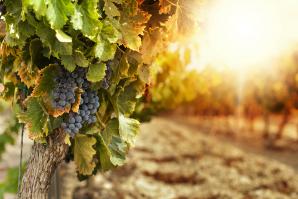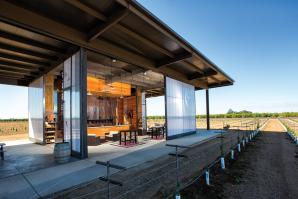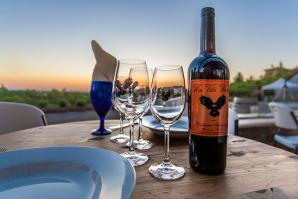Zinfandel from Lodi’s Mokelumne River American Viticultural Area comes in two main styles: west side and east side. West-side vineyards, with their shallower soil, have lusher growth and tend to be earthier or loamier, sometimes pungently compost-like. East-side vineyards have a lower water table, producing smaller clusters and smaller fruit, which generally have more color, tannin and acidity. (Other factors, such as rootstock and clonal variations, also have an effect.)
Ideally, you should be able to taste a Lodi Native wine and identify its origin. Need help? Follow Lodi wine expert Randy Caparoso on this virtual tasting tour through the six Lodi Native vineyards, starting with the youngest.
Wegat Vineyard
- 2012 Maley Brothers Lodi Native Zinfandel
- Grower: Todd Maley
- Winemaker: Chad Joseph
Planted in 1958 on St. George’s rootstock, the Wegat Vineyard sits on sandy loam. These vines produce looser, more cylindrical grape clusters with less acidity due to the high water table. The result is a lighter, softer Zinfandel with hints of the west side’s characteristic earthy, organic flavor and “a quality that one of the winemakers describes as voluptuous,” Caparoso says.
TruLux Vineyard
- 2012 McCay Cellars Lodi Native Zinfandel
- Growers: Keith and Craig Watts
- Winemaker: Michael McCay
The tall vines on this west-side vineyard date back to the 1940s. The clusters here tend to be smaller than your average Lodi Zinfandel, about the size of a softball. Thicker fruit skins give the wine a meatier taste, but not as heavy or sharp as the east-side wines. Given its location, you might taste traces of that loamy flavor, but not as much as the wines produced at Wegat.
Soucie Vineyard
- 2012 m2 Wines Lodi Native Zinfandel
- Grower: Kevin Soucie
- Winemaker: Layne Montgomery
The Soucie Vineyard was planted in 1916 and is the farthest west of all the Lodi Native sites, out near Interstate 5. But its deep, sandy soil also has the influence of the nearby Delta, which adds a richness to the texture. On its own rootstock, massive clusters produce a lot of fruit with high alcohol. But its aggressive, pungent and manure-like qualities make the wine an extreme version of a west-side Zin.
Noma Ranch
- 2012 Macchia Wines Lodi Native Zinfandel
- Grower: Leland Noma
- Winemaker: Tim Holdener
On the opposite end of town, you’ll find Noma Ranch, planted in the early 1900s. This self-maintained vineyard sits on a sandy hill, dry-farmed for most of its life. With small vines and deep roots, there is no need for water. Its small clusters produce a heavy, acidic wine bursting with fruit, which makes more sugar and, in turn, higher alcohol content (16 percent). No earthiness here.
Century Block Vineyard
- 2010 Fields Family Wines Lodi Native
- Grower: Russ Fields
- Winemaker: Ryan Sherman
This 3-acre easterm vineyard, planted around 1905, produces medium-size clusters with small berries. The level of tannin and acid, while not as high as at Noma Ranch, gives this Zinfandel a similar firm, full-bodied structure with sweet, red cherry notes. While this Lodi Native Zinfandel had its fans, Caparoso says the grower opted out of the upcoming vintage to do business with a big producer.
Marian’s Vineyard
- 2012 St. Amant Lodi Native Zinfandel
- Growers: Jerry & Bruce Fry
- Winemaker: Stuart Spencer
The oldest of the bunch, Marian’s Vineyard established its roots in 1901. Geographically, this 8-acre vineyard sits in the southwest but boasts an eastern style. The vines have big trunks that produce large, generous clusters. “It speaks to quality of the growers,” Caparoso says. “They don’t make the vines suffer.” The resulting wine is a full-bodied Zinfandel with a rich, creamy texture and flavors of dark fruit and cocoa with savory notes.
Recommended For You

Taste the Vineyard
Lodi vintners are taking a minimalist approach to create all-natural Zinfandels from heritage vines
You might say the old grapevines look otherworldly. With their contorted limbs and thick trunks, these Zinfandel vines look more like squat alien-trees, twisting up out of a sandy 3-acre spit of land in southwest Lodi. “Look how this vine is growing here,” says Stuart Spencer, owner of St. Amant Winery. He’s standing in the dirt at nearby Marian’s Vineyard, pointing to a vine with a hole as big as a fist. “The vine just splits over time.”

A Mature Palate
m2 Vintners has a laid-back vibe and high-end digs, reflecting the new image of Lodi wines
At the crush pad of a custom-built winery, the 6-foot-4 winemaker in tie-dye socks shuts off the forklift, realizing he missed a call.
“I didn’t hear my phone ring,” says Layne Montgomery, 55, general manager and founding partner of m2 Vintners Inc. in Acampo.
“It’s harvest,” jests one of his volunteers. “Who has time for a phone?”

Wine Winner
How Dr. Grover Lee went from the pharmacy to the vineyard
Imagine you’re a successful businessman, but what you really want to be is a professional baseball player. You’re so sure of yourself that you begin spending nights and weekends studying and training as if Major League Baseball will soon be calling. And then they actually do, and at your first at-bat, you clear the bases.
That’s pretty much how things happened when Granite Bay pharmacist Dr. Grover Lee decided to become an award-winning winemaker.

The Wine on Miracle Mile
Sacramento sommelier Paul Marsh joins Stockton’s business renaissance
For the past 10 years, Paul Marsh has pledged himself to the pursuit of wine. In Chico, he learned the intricacies of its fruit by planting and harvesting a vineyard. With Kendall Jackson, he learned to sell. At The Firehouse Restaurant in Old Sacramento, he was educated on the finer points of building a wine collection in a hospitality setting, and he became a certified sommelier.



